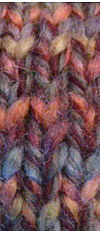- Medallion knitting
-
Medallion knitting produces flat knitted fabrics that are circular or polygons using a technique similar to the crochet of doilies, by progressively increasing or decreasing the radius.
The most difficult part of flat medallion knitting is increasing or decreasing at just the right rate. The circumference c of a circle is related to its radius r by the formula c = 2πr. Therefore, the number of stitches n in a row at radius r must exactly equal that circumference times the stitch gauge, if the medallion is to lie flat. If the number of stitches is fewer than this, the medallion will cup at its edges, forming a spherical bowl; if the number of stitches exceeds this, the medallion will frill at its edges, forming ruffles. Therefore, one should measure the radius regularly as the medallion is being knitted and determine the number of stitches that need to be increased or decreased in each round. Of course, these increases or decreases should be spread evenly around the circumference.
If the initial number of stitches were exactly correct and if every row were exactly the same height, flat medallions could be ensured by increasing or decreasing the same number of stitches Δn in every row using the formula
provided that Δn were exactly an integer. Most medallion knitting patterns implicitly assume that this will work, e.g., "increase five stitches per round". Unfortunately, the knitter's gauges may differ from those of the pattern-maker and may even change with the circumference, and Δn is rarely an integer, so it is usually better to use the method outlined in the previous paragraph.
References
- June Hemmons Hiatt (1988) The Principles of Knitting, Simon and Schuster, pp. 119-121. ISBN 0-671-55233-3
Categories:- Knitted fabrics
- Textile arts stubs
Wikimedia Foundation. 2010.


